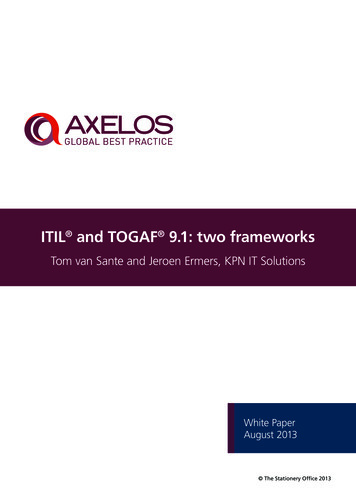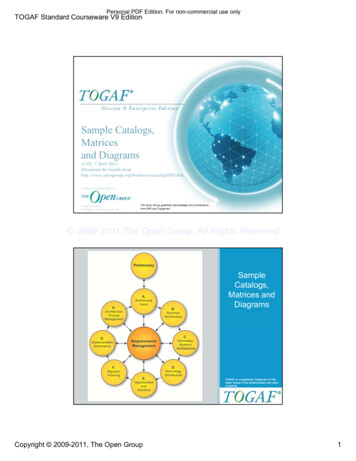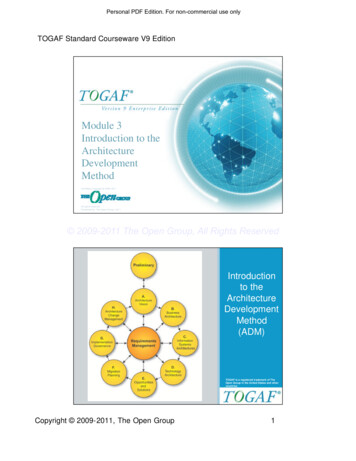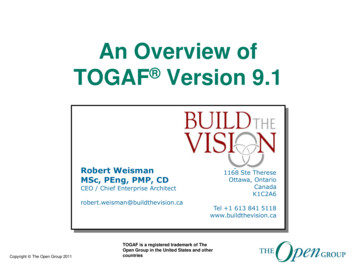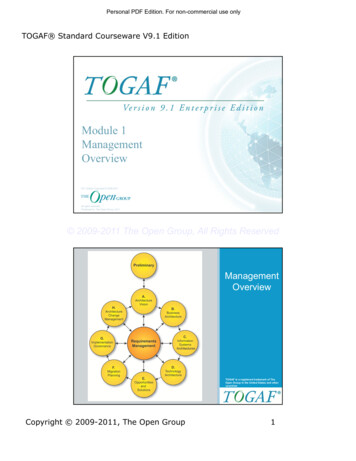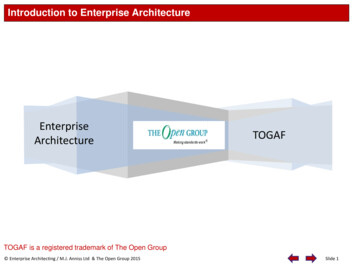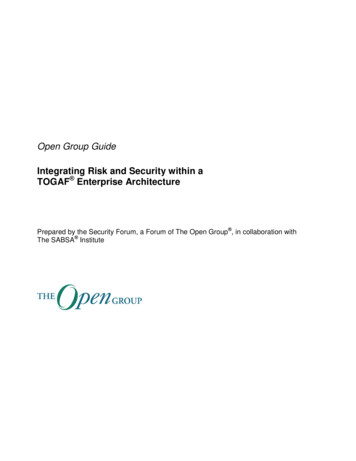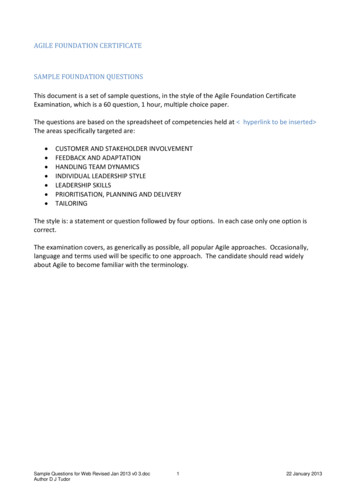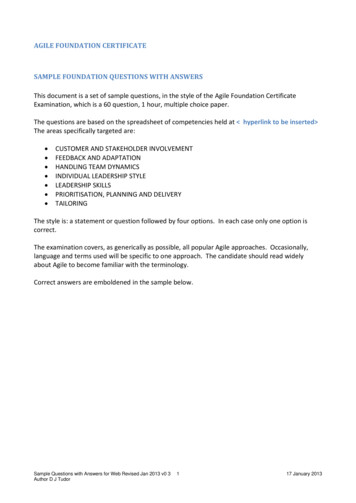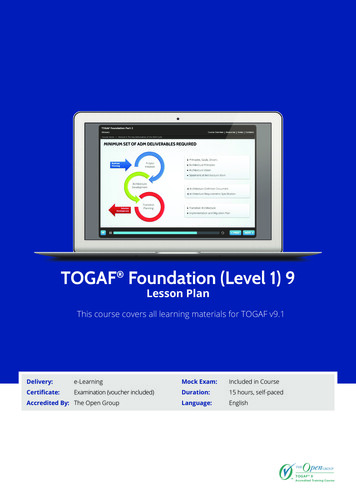
Transcription
TOGAF Foundation (Level 1) 9Lesson PlanThis course covers all learning materials for TOGAF v9.1Delivery:e-LearningMock Exam:Included in CourseCertificate:Examination (voucher included)Duration:15 hours, self-pacedLanguage:EnglishAccredited By: The Open GroupTMTOGAF 9Accredited Training Course
TOGAF Foundation (Level 1) 9 - Lesson PlanThis Lesson PlanContentsThis lesson plan provides you with all the informationabout the TOGAF Foundation (Level 1) 9 e-learningcourse. Before you begin your studies, please readthrough this document to help you plan your studyingand revision activities.Welcome3The Course3Who will Benefit from this Course?3Course Materials3Workbook4Quizzes4Mock Exam4Good luck!Tutor SupportContact your tutor at any point during the course onTOGAF-Tutor@goodelearning.com and they will get backto you within 24 hoursTechnical SupportUK 44(0) 8435 235 096USA 1(917) 472-9842support@goodelearning.comSystem RequirementsTo ensure you have the best possible experience, pleasemake sure your system matches the following minimumrequirements:Internet Browser (Windows or Mac) Google Chrome 14 or later Safari 5.1 or later Internet Explorer 6 and later Opera 9.5 and laterFlash Player Requirements Flash Player 10 or laterHow to Get Help from your TOGAF Trainer and Mentor 4Detailed Lesson PlanModule 1: The TOGAF Certification Program55Module 2: The Basic Concepts of EnterpriseArchitecture and TOGAF5Module 3: The Core Concepts of TOGAF 95Module 4: Introduction to the ArchitectureDevelopment Method (ADM)6Module 5: The ADM Cycle and the Objectives ofEach Phase6Module 6: The ADM Guidelines and Techniques6Module 7: Views, Viewpoints and StakeholderCommunication7Module 8: The Concept of Building Blocks7Module 9: The Key Deliverables of the ADM Cycle7Module 10: The Concept of Enterprise Continuum 8Module 11: The Key Deliverables of the ADM Cycle 8Module 12: The TOGAF Reference Models8Module 13: Architecture Governance and the ADM 9Module 14: Revision Module - Key Learning Points 9Module 15: Practice Exam9Still having issues with playback? Check the performance of your broadband internetconnection Clear your cache and log back in After more than 30mins of inactivity, you may notbe able to hear audio. To fix this just log out and logback in again. Copyright 2014 Good e-Learning. All rights reserved. No part of this publication may be reproduced, resold, stored in a retrieval system, or distributed in any form or by any means,electronic, mechanical, photocopying, recording, or otherwise, without the prior permission of the copyright owner. Such requests for permission or any other comments relating to thematerial contained in this document may be submitted to: marketing@goodelearning.com. Good e-Learning is a trading name used by Educational Systems Ltd.TOGAF is a registered trademark of The Open Group.2
TOGAF Foundation (Level 1) 9 - Lesson PlanWelcome Welcome to the TOGAF Foundation (Level 1) 9e-learning courseHow each of the ADM phases contributes to thesuccess of Enterprise Architecture The ADM guidelines and techniques The course contains a number of interactive slides,videos, and audio tuition How Architecture Governance contributes to theArchitecture Development Cycle You may stop and start the course whenever you like- you can learn on-demand. The concepts of views and viewpoints and their rolein communicating with stakeholders Do not try and cover too much material at once; abenefit of e-learning is that you can take your time The concept of building blocks The key deliverables of the ADM cycleUse the quizzes to check that you have understoodthe key learning points of each module. Where youhave answered incorrectly, read the guidance, andthen review that topic again. The TOGAF reference models The TOGAF certification program Remember you can contact a TOGAF tutor at anytime, and you will receive a response by email replywithin 24 hours.The purpose of the Foundation Certificate is to confirmyou have sufficient knowledge and understanding ofthe TOGAF 9 Framework, a good knowledge of the coreTOGAF principles and concepts and will enable you toprepare for and sit the TOGAF Foundation exam. This isthe first part of a 2-part qualification. You must pass thefoundation level exam before you can prepare for thesecond part, TOGAF Certified.There are 2 objectives of this course. The first is to makeit easy for you to learn about TOGAF 9. You also want topass the exam! It is the aim of the course to satisfy both.As you go through this course, you will be introducedto many new concepts that are likely to be unfamiliar toyou – for this reason we recommend that you revisit thiscourse a second time after completing it, to reinforce theconcepts you learnt.The CourseThis course is based on the TOGAF 9.1 FoundationExam syllabus with a focus on learning and retaininginformation. TOGAF terms are explained in detail foryour benefit and are supported with examples.The course materials provided in the Foundatione-learning course will provide you with all theinformation you need for this exam. At a high level, youwill learn about:The TOGAF 9.1 standard is managed by The Open Groupand can be accessed online through the following doc/arch/It is not, however, required reading for the TOGAF 9foundation certificate - this course will provide youwith all the learning materials that you need to pass atFoundation level. Nevertheless, throughout the coursethere are links to relevant bookmarks of the onlinestandard that you can jump to if you would like tosupplement your studies.Who will Benefit from this Course?This course is ideal for individuals or teams who wish to: Learn about the TOGAF 9 standard Achieve a globally recognized qualification Professionals who are working in roles associatedwith an architecture project Achieve Level 2 certification and become a certifiedTOGAF professionalCourse MaterialsUpon enrolment in the course you have access to thefollowing materials.A number of video tutorials, comprising colour slideswith voiceover, covering the following Sections andModules:1:The TOGAF 9 certification program The basic concepts of Enterprise Architecture andthe TOGAF standard2: The basic concepts of Enterprise Architectureand TOGAF The core concepts of the TOGAF 9 standard3: The key terminology of the TOGAF 9 standard The ADM cycle and the objectives of each phase, andhow to adapt and scope the ADM4: How each of the ADM phases contributes to thesuccess of enterprise architecture The concept of the Enterprise Continuum; itspurpose and constituent partsThe core concepts of TOGAF5: The ADM cycle and the objectives of each phase,and how to adapt and scope the ADM6:The ADM guidelines and techniques Copyright 2014 Good e-Learning. All rights reserved. No part of this publication may be reproduced, resold, stored in a retrieval system, or distributed in any form or by any means,electronic, mechanical, photocopying, recording, or otherwise, without the prior permission of the copyright owner. Such requests for permission or any other comments relating to thematerial contained in this document may be submitted to: marketing@goodelearning.com. Good e-Learning is a trading name used by Educational Systems Ltd.TOGAF is a registered trademark of The Open Group.3
TOGAF Foundation (Level 1) 9 - Lesson Plan7: The concepts of views and viewpoints and their rolein communicating with stakeholders8:The concept of building blocks9:The key deliverables of the ADM cycle10: The concept of the Enterprise Continuum; itspurpose and constituent parts11: The Architecture Repository12: The TOGAF reference models13: How Architecture Governance contributes to theArchitecture Development CycleYou will also receive: A Mock exam simulator, with answers An online searchable glossary, with definitions A number of additional downloadable resourcesHow to Get Help from your TOGAF Trainerand MentorFor all enquiries, our Lead TOGAF Tutor can bereached by e-mail (TOGAF-tutor@goodelearning.com)or if you click a link from the ‘support section’ withinthe e-learning course (see below). You will receive aresponse to your TOGAF question or query within 24 hrs.Please download the ‘About the Exam’document for more information, and afull description of the process.WorkbookThe Foundation course contains a workbook thatcan be downloaded as a PDF. It’s purpose is to allowyou to make notes as you work through the coursethese notest can then form the basis of your exampreparation. You can either print out a copy of theworkbook and write notes by hand, or edit the PDFdirectly. Please note that the latter is only possible withAdobe PDF reader 11 or newer.QuizzesEvery module contains a number of multiple choice quizquestions. Their purpose is to test your knowledge andprepare you for the TOGAF exam questions. By havingthese quiz sessions after each module, you will gainconfidence that you are meeting the learning objectivesrequired for Foundation certification.Mock ExamWe strongly encourage you to attempt the mock exampaper, which simulates exam conditions that you willface for the real thing. Don’t forget, tutor support isavailable if you are having issues with your studies. Copyright 2014 Good e-Learning. All rights reserved. No part of this publication may be reproduced, resold, stored in a retrieval system, or distributed in any form or by any means,electronic, mechanical, photocopying, recording, or otherwise, without the prior permission of the copyright owner. Such requests for permission or any other comments relating to thematerial contained in this document may be submitted to: marketing@goodelearning.com. Good e-Learning is a trading name used by Educational Systems Ltd.TOGAF is a registered trademark of The Open Group.4
TOGAF Foundation (Level 1) 9 - Lesson PlanDetailed Lesson PlanThe following tables summarize each of the modules, their learning objectives, and the method(s) of delivery. Thetotal studying time required for this course is 15 hours.Module 1: The TOGAF Certification ProgramThe purpose of the first module is to introduce you to the TOGAF 9 Certification program and the benefits ofbecoming TOGAF certified.Session TitleLearning ObjectiveDelivery MethodIntroductionDurationModule ContentsSlidesTutorial Slides and VoiceoverWorkbookWhy TOGAF Certification for People?TOGAF Certification ProgramModule 2: The Basic Concepts of Enterprise Architecture and TOGAFThis module introduces the basic concepts of enterprise architecture, The Open Group and the TOGAF architectureframework. What is an enterprise? What is enterprise architecture? What is a framework? These are some of thebasic concepts that the module will cover as an introduction to the world of enterprise architecture.Session TitleDurationLearning ObjectiveDelivery MethodIntroductionModule ContentsSlidesTutorial Slides and VoiceoverEnterprise Architecture BackgroundInterview with Allen Brown - CEO of the Open GroupArchitecture in the TOGAF Context?TOGAF BackgroundArchitecture TypesTOGAF 9 ComponentsWhat is the Value of TOGAF as an Architecture FrameworkWhat is an Architecture Framework?TOGAF ComponentsModule 3: The Core Concepts of TOGAF 9The TOGAF 9 architecture framework is divided into 7 parts, each part addressing a different aspect of thearchitecture framework. This module will introduce you to the different parts of the TOGAF 9 architecture frameworkand you will be able to distinguish between the Architecture Development Method, Architecture Content Frameworkand the Architecture Capability Framework.Session TitleDurationLearning ObjectiveDelivery MethodIntroductionModule ContentsSlidesTutorial Slides and VoiceoverQuizThe Architecture Development MethodADM Guidelines and TechniquesArchitecture Content FrameworkEnterprise ContinuumDeliverables, Artifacts and Building BlocksArchitecture RepositoryEstablishing the Architecture Capability as an Operational EntityArchitecture Capability FrameworkDocument Categorization ModelMultiple Choice Questions(5) Copyright 2014 Good e-Learning. All rights reserved. No part of this publication may be reproduced, resold, stored in a retrieval system, or distributed in any form or by any means,electronic, mechanical, photocopying, recording, or otherwise, without the prior permission of the copyright owner. Such requests for permission or any other comments relating to thematerial contained in this document may be submitted to: marketing@goodelearning.com. Good e-Learning is a trading name used by Educational Systems Ltd.TOGAF is a registered trademark of The Open Group.5
TOGAF Foundation (Level 1) 9 - Lesson PlanModule 4: Introduction to the Architecture Development Method (ADM)The purpose of module 4 is to introduce you to the Architecture Development Method cycle by briefly explainingthe objective of each phase in the cycle and how to adapt the method for use in an organization. You should nowunderstand the objectives of all the phases in the Architecture Development Method, including the PreliminaryPhase and Requirements Management.Session TitleDurationLearning ObjectiveDelivery MethodIntroductionModule ContentsSlidesTutorial Slides and VoiceoverADM Governance Q&AConstraining the Scope of Architectural ActivitiesTOGAF ADM PhasesADM Phase StepsModule 5: The ADM Cycle and the Objectives of Each PhaseThe focus on the Architecture Development Method continues in this module by looking at each of the methodphases in more detail. The aim is to understand how each phase contributes to the success of enterprisearchitecture by focusing on the approach for each phase.Session TitleDurationLearning ObjectiveDelivery MethodIntroductionModule ContentsSlidesTutorial Slides and VoiceoverTOGAF ADM OverviewRequirements Management in the ADMADM Objectives and ApproachQuizMultiple Choice Questions(5)Module 6: The ADM Guidelines and TechniquesAt this stage of the course you should have a good understanding of each phases of the architecture developmentmethod.In module 6 we introduce the Architecture Development Method Guidelines and Techniques that are available toarchitects when they are executing the different phases of the method, including business scenarios, architectureprinciples and the gap analysis technique.For the foundation level exam you must understand the objectives of the different guidelines and techniques butyou are not required to understand how to implement a technique on a project.Session TitleLearning ObjectiveDelivery MethodIntroductionDurationModule ContentsSlidesTutorial Slides and VoiceoverQuizTOGAF 9 Contains Architecture GuidelinesTOGAF 9 Contains Architecture TechniquesArchitecture PrinciplesBusiness Transformation Readiness ProgramRisk ManagementCapability Based PlanningInteroperabilityBusiness ScenarioEnterprise Operating ModelGAP AnalysisMultiple Choice Questions(5) Copyright 2014 Good e-Learning. All rights reserved. No part of this publication may be reproduced, resold, stored in a retrieval system, or distributed in any form or by any means,electronic, mechanical, photocopying, recording, or otherwise, without the prior permission of the copyright owner. Such requests for permission or any other comments relating to thematerial contained in this document may be submitted to: marketing@goodelearning.com. Good e-Learning is a trading name used by Educational Systems Ltd.TOGAF is a registered trademark of The Open Group.6
TOGAF Foundation (Level 1) 9 - Lesson PlanModule 7: Views, Viewpoints and Stakeholder CommunicationGood stakeholder communication is a key requirement to successfully create an architecture definition in TOGAF 9.This module studies the concepts of views and viewpoints using the ISO 42010 standard, which is an internationalstandard supported by TOGAF and used to define the viewpoints in the TOGAF Content Framework.Session TitleLearning ObjectiveDelivery MethodIntroductionDurationModule ContentsSlidesTutorial Slides and VoiceoverISO/IEC 42010:2007Views and ViewpointsStakeholders and ConcernsA Single Example of a ViewA Single Example of a ViewpointView CreationModule 8: The Concept of Building BlocksA key benefit of enterprise architecture is the ability to re-use architecture, business or technology components ondifferent projects or in different parts of the organization.The concept of architecture and solution building blocks is described in this module, including the use of buildingblocks as reusable components within TOGAF.Session TitleLearning ObjectiveDelivery MethodIntroductionDurationModule ContentsSlidesTutorial Slides and VoiceoverIntroduction of Building BlocksBuilding Blocks and the ADMArchitecture PatternsTOGAF Building Block ExampleModule 9: The Key Deliverables of the ADM CycleDuring each phase of the Architecture Development Method a set of key deliverables are generated. Thesedeliverables are used as the input for other phases and as the outputs that are consumed by a wide range ofstakeholders.The purpose of module 9 is to highlight the key deliverables of each phase in the Architecture Development Method.Session TitleLearning ObjectiveDelivery MethodIntroductionDurationModule ContentsSlidesTutorial Slides and VoiceoverQuizADM DeliverablesBaseline Set of TOGAF Deliverables Minimum Set of ADM Deliverables Required to SuccessfullyImplement TOGAF 9Multiple Choice Questions(5) Copyright 2014 Good e-Learning. All rights reserved. No part of this publication may be reproduced, resold, stored in a retrieval system, or distributed in any form or by any means,electronic, mechanical, photocopying, recording, or otherwise, without the prior permission of the copyright owner. Such requests for permission or any other comments relating to thematerial contained in this document may be submitted to: marketing@goodelearning.com. Good e-Learning is a trading name used by Educational Systems Ltd.TOGAF is a registered trademark of The Open Group.7
TOGAF Foundation (Level 1) 9 - Lesson PlanModule 10: The Concept of Enterprise ContinuumThe Enterprise Continuum is a classification schema that can be used to organize the content of your enterpriserepositories.In this module we will explain the concept of the Enterprise Continuum together with its purpose, and constituentparts. You should also understand that the architecture continuum and solutions continuum are both componentsof the enterprise continuum.Session TitleLearning ObjectiveDelivery MethodIntroductionDurationModule ContentsSlidesTutorial Slides and VoiceoverArchitecture Continuum DemoThe Enterprise ContinuumThe Architecture ContinuumTools can Model the Enterprise ArchitectureIssues in Tools StandardizationTools Evaluation CriteriaModule 11: The Key Deliverables of the ADM CycleIn module 11 we will have a closer look at the architecture repository, which is used to store and managearchitecture content produced and consumed by the Architecture Development Method.You will be able to see that you need more from an architecture repository than just being able to store yourarchitecture models!Session TitleDurationLearning ObjectiveDelivery MethodIntroductionModule ContentsSlidesTutorial Slides and VoiceoverThe Architecture Repository in the Context of the ADMThe Architecture RepositoryStandards Information Base Repository AreaThe Architecture Repository Structural FrameworkArchitecture Landscape Repository AreaStandards Within the Standards Information BaseGovernance Log Repository AreaQuizMultiple Choice Questions(5)Module 12: The TOGAF Reference ModelsIn this module we will introduce the two core reference models for foundation and common systems architecturedefined in TOGAF that you can be added to the Architecture Continuum: the Technical Reference Model (TRM) andthe Integrated Information Infrastructure Reference model (III-RM).Session TitleLearning ObjectiveDelivery MethodIntroductionDurationModule ContentsSlidesTutorial Slides and VoiceoverQuizTechnical Reference ModelPositioning the TRM & III-RMIII-RMMultiple Choice Questions(4) Copyright 2014 Good e-Learning. All rights reserved. No part of this publication may be reproduced, resold, stored in a retrieval system, or distributed in any form or by any means,electronic, mechanical, photocopying, recording, or otherwise, without the prior permission of the copyright owner. Such requests for permission or any other comments relating to thematerial contained in this document may be submitted to: marketing@goodelearning.com. Good e-Learning is a trading name used by Educational Systems Ltd.TOGAF is a registered trademark of The Open Group.8
TOGAF Foundation (Level 1) 9 - Lesson PlanModule 13: Architecture Governance and the ADMThe last module of this course focuses on the “people” side of architecture by introducing you to the architecturegovernance concepts available in TOGAF.You will look at the Architecture Capability Framework, and specifically, how architecture governance contributes tothe successful execution of the Architecture Development Cycle.You should now realize how important it is to govern architecture within your organization.Session TitleDurationLearning ObjectiveDelivery MethodIntroductionModule ContentsSlidesTutorial Slides and Voiceover rchitecture Board, Governance Framework, Compliance ReviewsA& DispensationsIntroduction to GovernanceGovernance ModelArchitecture ComplianceEstablishing an Architecture CapabilityQuizMultiple Choice Questions(5)Module 14: Revision Module - Key Learning PointsThis module looks again at the key concepts and learning outcomes for TOGAF Foundation level certification andshould be used an aid when preparing for your exam.It is structured to reflect the key learning units required to pass the foundation level exam. Each learning unitis linked to the appropriate sections in the online TOGAF standard to enable you to quickly refer to the sourceinformation.Module 15: Practice ExamSee how much you have learnt so far by taking a mock up test modelled on the actual Foundation Level Exam. Copyright 2014 Good e-Learning. All rights reserved. No part of this publication may be reproduced, resold, stored in a retrieval system, or distributed in any form or by any means,electronic, mechanical, photocopying, recording, or otherwise, without the prior permission of the copyright owner. Such requests for permission or any other comments relating to thematerial contained in this document may be submitted to: marketing@goodelearning.com. Good e-Learning is a trading name used by Educational Systems Ltd.TOGAF is a registered trademark of The Open Group.9
TOGAF principles and concepts and will enable you to prepare for and sit the TOGAF Foundation exam. This is the first part of a 2-part qualification. You must pass the foundation level exam before you can prepare for the second part, TOGAF Certified. There are 2 objectives of this course. The
